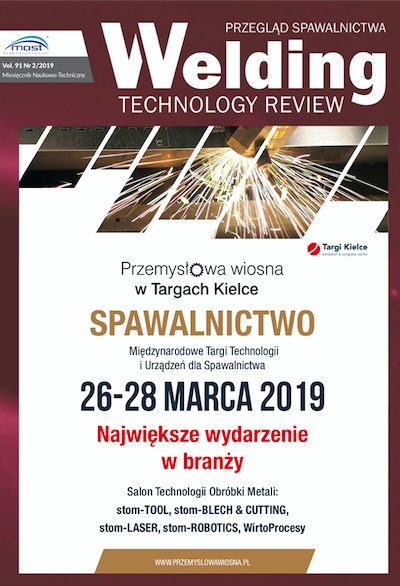The laboratory tests of hybrid layers combining hardfacing and nitriding dedicated to increase the durability of forging tools in hot forging processes
Main Article Content
Abstract
In response to the growing need to use wear-resistant layers that increase durability of tools in forging pro-cesses, hybrid layers have been proposed that combine hardfacing with nitriding treatment. This article presents the results of laboratory tests of surface wear-resistant layers made with a new hybrid technology Gas-Shielded Metal Arc surfacing (hardfacing) with ZeroFlow gas nitriding. Specimens made with hardfacing or nitriding were prepared and examined. Analysis covered the thorough microstructure study, EDX chemical composition analysis and microhardness analysis. In experiment, 3 different types of nitrided layers were proposed for alpha, gamma prim and epsilon nitrides in the surface layer. The results of metallographic research in the surface layer was presented. The analysis of chemical composition in the particular overlay welds was performed to determine the content of alloying elements in the particular overlay welds. The susceptibility to nitriding of used weld materials as well as the ability to form particular types of nitrides on selected welded substrates was also tested.
Downloads
Article Details
Creative Commons CC BY 4.0 https://creativecommons.org/licenses/by/4.0/
Welding Technology Review (WTR) articles are published open access under a CC BY licence (Creative Commons Attribution 4.0 International licence). The CC BY licence is the most open licence available and considered the industry 'gold standard' for open access; it is also preferred by many funders. This licence allows readers to copy and redistribute the material in any medium or format, and to alter, transform, or build upon the material, including for commercial use, providing the original author is credited.
References
Zwierzchowski M., Factors Affecting the Wear Resistance of Forging Tools, Archives of Metallurgy and Materials, 2017, Vol. 62 (3), 1567-1576.
https://doi.org/10.1515/amm-2017-0240. DOI: https://doi.org/10.1515/amm-2017-0240
Choi C., Groseclose A., Altan T., Estimation of plastic deformation and abrasive wear in warm forging dies, Journal of Materials Processing Technology, 2012, Vol. 212 (8), 1742-1752. DOI: https://doi.org/10.1016/j.jmatprotec.2012.03.023
Bayramoglu M., Polat H., Geren N., Cost and performance evaluation of different surface treated dies for hot forging process, Journal of Materials Processing Technology, 2008, Vol. 205 (1-3), 394-403. DOI: https://doi.org/10.1016/j.jmatprotec.2007.11.256
https://doi. org/10.1016/j.jmatprotec.2007.11.256.
Małdzinski L., Liliental W., Tymowski G., Tacikowski J., New possibilities for controlling gas nitriding process by simulation of growth kinetics of nitride layers, Surface Engineering, 1999, Vol. 15 (5), 377-384.
doi: 10.1179/026708499101516740. DOI: https://doi.org/10.1179/026708499101516740
Małdziński L., Ostrowska K., Okoniewicz P., Controlled ZeroFlow gas nitriding as a method increasing the durability of dies for hot extrusion of aluminum profiles, Metal Forming, Obróbka Plastyczna Metali, 2014, Vol. XXV (3), 169-183.
Lazić V., Arsić D., Nikolić R., Reparation of damaged forging dies by hard facing (HF) technology, Production Engineering Archives, 2015, Vol. 6 (1), 26-29.
DOI: 10.30657/pea.2017.06.07. DOI: https://doi.org/10.30657/pea.2017.06.07
Hawryluk M., Gronostajski Z., Widomski P., Influence of the application of a PN+CrN hybrid layer on improvement of the lifetime of hot forging tools, Journal of Materials Processing Technology, 2018, Vol. 258, 226-238. https://doi.org/10.1016/j.jmatprotec.2018.03.029. DOI: https://doi.org/10.1016/j.jmatprotec.2018.03.029
Gronostajski Z., Widomski P., Kaszuba M., Zwierzchowski M., Hawryluk M., Influence of both hardfaced and nitrided layers on the durability of hot forging tools, Surface Innovations, 2018, Vol. 6 (4-5), 301-310.
https://doi.org/10.1680/jsuin.18.00021. DOI: https://doi.org/10.1680/jsuin.18.00021
Yokoyama H., Iio M., (2015) Engine Valve Japanese Patent JP 2012077998 W 20121030, EP 2915965 A1.
Alphonsa J., Padsala B.A., Chauhan B.J., Plasma nitriding on welded joints of AISI 304 stainless steel, Surface and Coatings Technology, 2013, Vol. 228 (Supl1), S306-S311. https://doi.org/10.1016/j.surfcoat.2012.05.113. DOI: https://doi.org/10.1016/j.surfcoat.2012.05.113
Lukin V.I., Kovalchuk V.G., Golev Y.V., Mazalov I.S., Ovchenkova I.I., Welding a creep-resisting NiCoCr (VZh171) alloy strengthened by nitriding, Welding International, 2013, Vol. 27 (11), 897-902.
DOI: 10.1080/09507116.2013.796642. DOI: https://doi.org/10.1080/09507116.2013.796642
Berkowski L., Wpływ struktury na skutki azotowania chromowych stali ledeburytycznych, część 1: Informacje o materiale do badań, Obróbka Plastyczna Metali, 2005, Vol. 1 (5).
